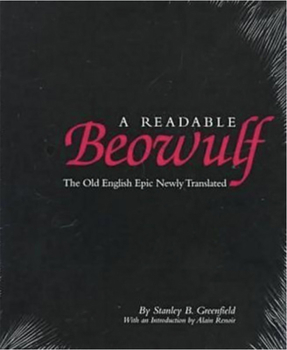A Readable Beowulf: The Old English Epic Newly Translated
Select Format
Select Condition 
Book Overview
Stanley B. Greenfield, one of the world's foremost Anglo-Saxon scholars, writes of why, after more than thirty years of study, he undertook the Herculean task of rendering Beowulf into contemporary verse: "I wanted my translation to be not only faithful to the original but, as the late John Lennon would have put it, 'A Poem in Its Own Write.' I wanted it to 'flow, ' to be easy to read, with the narrative movement of a modern prose...
Format:Paperback
Language:English
ISBN:0809310600
ISBN13:9780809310609
Release Date:May 1982
Publisher:Southern Illinois University Press
Length:176 Pages
Weight:0.75 lbs.
Dimensions:0.5" x 6.9" x 8.6"
Customer Reviews
1 rating
Ian Myles Slater on: An Experiment in Translation
Published by Thriftbooks.com User , 19 years ago
In this translation of "Beowulf," the translator set himself the very difficult task of working in a meter which suggests that of the original, but does not depend directly on either its obvious feature of alliteration (likeness of initial sounds of stressed words) or the less obvious patterns of length and stress. The goal, as he explains in "On the Translation," was equivalency, not imitation. The metrical resemblance is to be found in whole passages, not in specific lines and half-lines. His choice for this was the unusual purely syllabic line, avoiding use of the standard modern English reliance on metrical units, or feet, with the difference between stressed and unstressed syllables. The lines are mainly nine syllables long, with some shorter or longer (eight or ten), which does reflect the presence of actual variations in Old English meter. This syllabic line tends to produce a caesura, or mid-line pause, which is another marked feature of the original. (In fact, Benjamin Thorpe, an early nineteenth-century editor of "Beowulf," printed the half-lines as individual lines, doubling the apparent length, confusing the distinction been pauses and the ends of verses, and sometimes obscuring the alliteration linking half-lines.) Alliteration appears in the translation, but is not used as a structural principle; a decision which allows for more freedom to select the right word, instead of the one that fits with the rest of the line. (Old English verse had a large specialized vocabulary to fit these needs, with many ways to say things like "sword," or "warrior," or "king" -- areas in which modern vocabulary is comparatively impoverished.) The resulting translation flows nicely. Concise footnotes supply clear explanations; and there is additional information in the "Glossary of Proper Names." I have a test for translations from the (few) languages with which I have some familiarity. Is a comparison with the original language mutually enlightening? Does it offer interesting ways of looking at the original, and suggest new layers of meaning in the translation? In this case, some of Greenfield's accomplishments will be noticed only by those already familiar with the Old English, or with a copy of it open while reading the translation. He often uses a Modern English cognate (related by common origin) word, or at least a homophonous (sound-alike) term, (whatever the exact etymology) -- although always a clear modern expression, never an obscure and archaic, or completely obsolete word, in the manner of William Morris. (Who at points in his notoriously odd nineteenth-century verse translation seems to have been trying to translate the Old English of "Beowulf" into something rather like the Middle English of Chaucer; a rather pointless exercise, requiring a glossary of its own.) With Greenfield, the result is sometimes a quiet pun. Near the opening lines, we learn of a Danish ruler; "Often Scyld Scefing shattered the hosts, / unsettled many a nation





